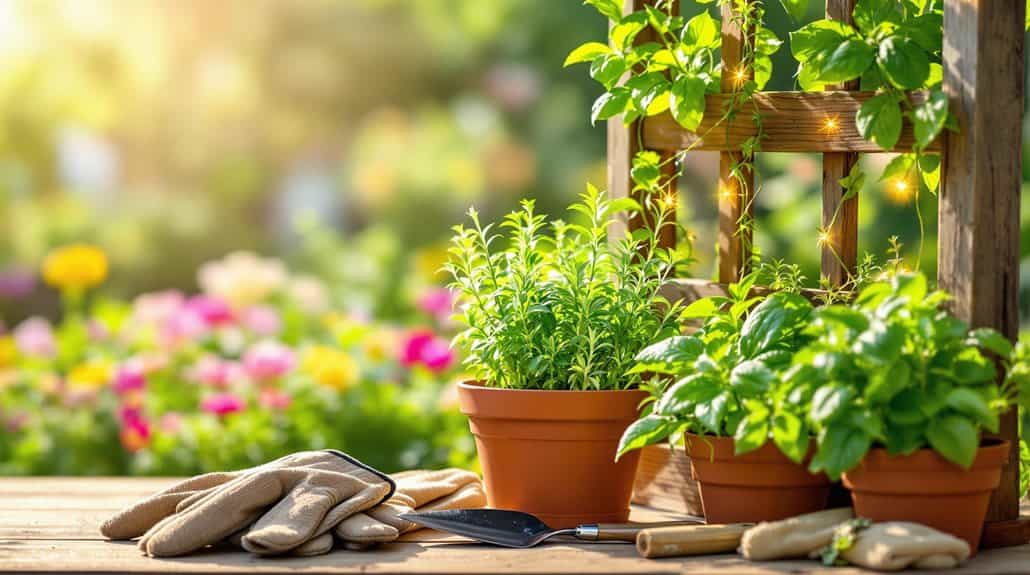Growing a Culinary Herb Garden: A Beginner’s Guide
If you're considering starting a culinary herb garden, you're on a path that can alter your cooking experience. You'll want to think about which herbs will thrive in your climate and how to prepare your garden site effectively. From selecting the right herbs to understanding soil requirements, each decision plays a crucial role in your garden's success. But it doesn't stop there; maintaining your herbs involves regular care and attention. What are the essential steps to guarantee your garden flourishes and provides a steady supply of fresh flavors?
TLDR
- Choose herbs based on sunlight needs, growth habits, and whether they are annuals or perennials for a successful garden layout.
- Ensure well-draining, nutrient-rich soil by adding compost and selecting the right soil type for your chosen herbs.
- Water herbs appropriately, focusing on the base to prevent diseases, and monitor moisture levels regularly.
- Harvest herbs in spring or early summer, using sharp tools and following the 1/3 rule to promote healthy growth.
- Utilize herbs in cooking for flavor enhancement and health benefits, and learn proper drying techniques for preservation.
Choosing the Right Herbs
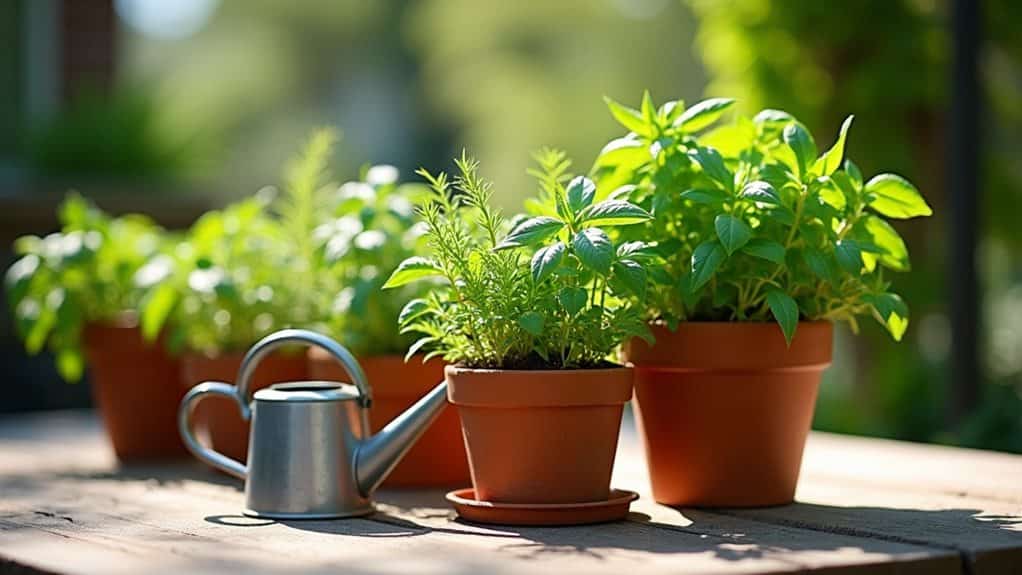
When choosing the right herbs for your garden, consider three key factors: the type of herb, its sunlight needs, and how much space it requires.
Pick annuals like basil if you love fresh pesto every year, or go for perennials like rosemary for a reliable buddy. Most herbs require full sun for optimal growth, so be sure to place them in a sunny spot in your garden. Just remember, mint could take over your yard, so keep it in check, alright? Additionally, be mindful of excessive direct sunlight, as too much can lead to browning leaves and affect your herbs' health. Happy gardening!
Preparing the Garden Site
After choosing the right herbs, the next step is preparing the garden site.
Find a sunny spot—at least six hours of sunlight is key!
Loosen up the soil, and don't forget those pesky stones. Using Well-draining soil is essential for optimal herb growth, as it prevents waterlogging and promotes healthy root development.
Add some compost for goodness. If you're feeling fancy, use stepping stones for easy access.
Trust me, your future self will thank you when it's harvest time! Remember, maintaining lawn health can also enhance the overall garden environment by reducing pests and promoting better growth.
Soil and Planting
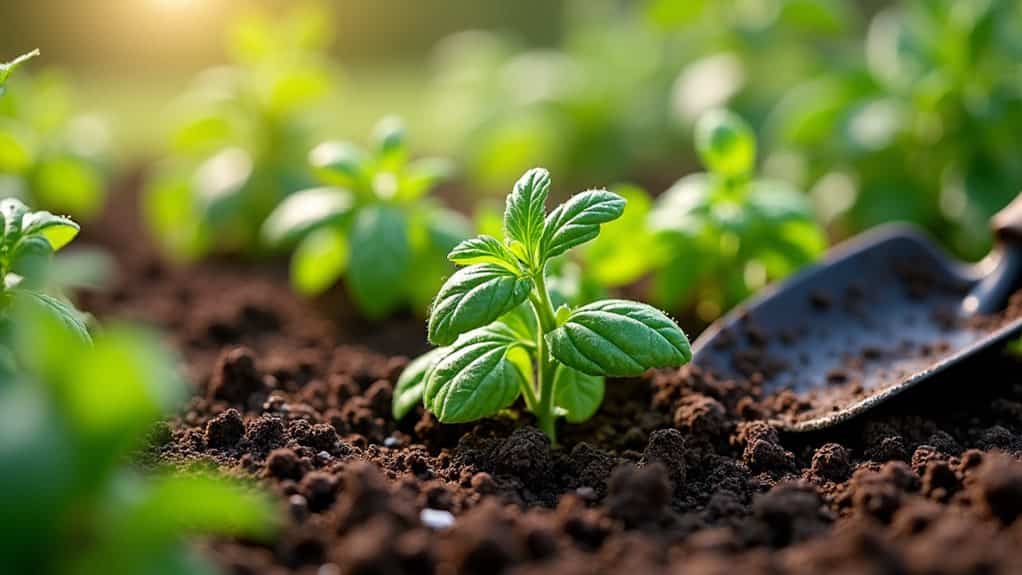
Starting with the right soil is crucial for a thriving herb garden. Most herbs love well-draining soil to keep their roots happy and healthy—no one wants root rot! Overwatering leads to yellow leaves that can inhibit growth and vitality.
Mediterranean herbs, like rosemary, enjoy gritty soil, while basil and parsley prefer something more fertile. Growing herbs is simple and can be less prone to diseases and insects compared to vegetables.
Mix in compost to enhance nutrients, and remember, loamy soil is like a spa day for your herbs! Happy planting!
Watering and Maintenance
How do you keep your herbs thriving? Start by watering based on the weather!
In hot spells, you might need to water daily, while cooler days call for just once a week.
Remember, it's all about the roots—water at the base and keep those leaves dry. Regular soil monitoring is essential to ensure your herbs receive the right amount of moisture.
And hey, no one likes soggy feet, so make certain good drainage! Moisture management is crucial for maintaining healthy growth in your herb garden.
Happy herb gardening!
Harvesting Herbs
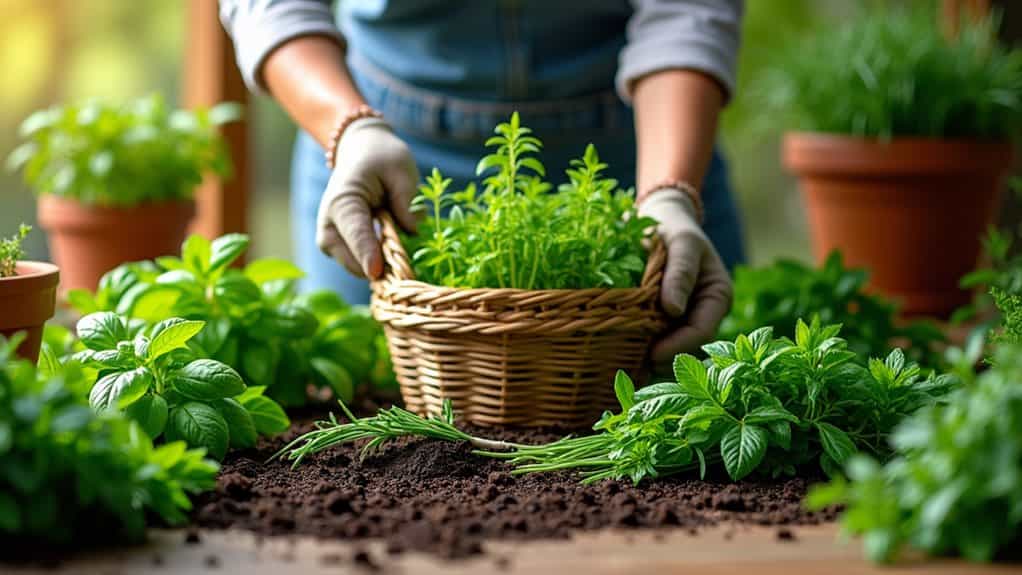
Harvesting herbs is a rewarding process that allows you to enjoy the fruits of your labor while promoting further growth. Aim to snip your herbs in spring or early summer, before they bloom. Remember the 1/3 rule—take just a third of each plant. Harvesting leafy perennials like oregano and thyme can be done by cutting long sprigs, ensuring a clean cut for continued growth. Black iron pipes are preferred for gas applications, just as proper techniques are essential for optimal herb growth. Harvest in the morning for the best flavor. So, grab those scissors and get to work! Your taste buds will thank you!
Pruning Techniques
Pruning your herbs isn't just a chore; it's like giving them a fresh haircut that helps them grow even better! You'll want to grab the right tools, like sharp scissors or clippers, and time it just right to keep those plants happy and healthy. Regular pruning helps to promote healthy shaping and growth of mature plants, ensuring they reach their full potential. So, are you ready to alter your herb garden into a lush paradise? Let's get into the nitty-gritty of why regular pruning matters and when to do it!
Importance of Regular Pruning
Regular pruning is essential for maintaining a lively culinary herb garden. You'll love how it encourages healthy growth and keeps your plants bushy and full, rather than looking like sad little sticks. Plus, it helps prevent overcrowding and lets air circulate, keeping diseases at bay. Furthermore, pruning during active growth promotes robust development and ensures your herbs thrive throughout the growing season.
Tools for Effective Pruning
When it comes to effective pruning, having the right tools can make all the difference. Grab some herb snippers or small scissors—they're perfect for delicate jobs! With sharp blades, you'll snip without damaging your plants. Remember, cut just above pairs of leaves to encourage new growth and keep your herbs bushy and happy. Zyliss products are designed for efficiency and effectiveness, making them a great choice for your herb garden. Trust me, your garden will thank you!
Best Times to Prune
Typically, the best times to prune your herbs are during the morning and early spring. Morning pruning's like a wake-up call for your plants, enhancing their aroma and flavor while keeping them cool and stress-free. Plus, early spring is prime time for growth! Additionally, woody herbs benefit from annual pruning during this season, ensuring they remain healthy and productive.
Common Herb Varieties
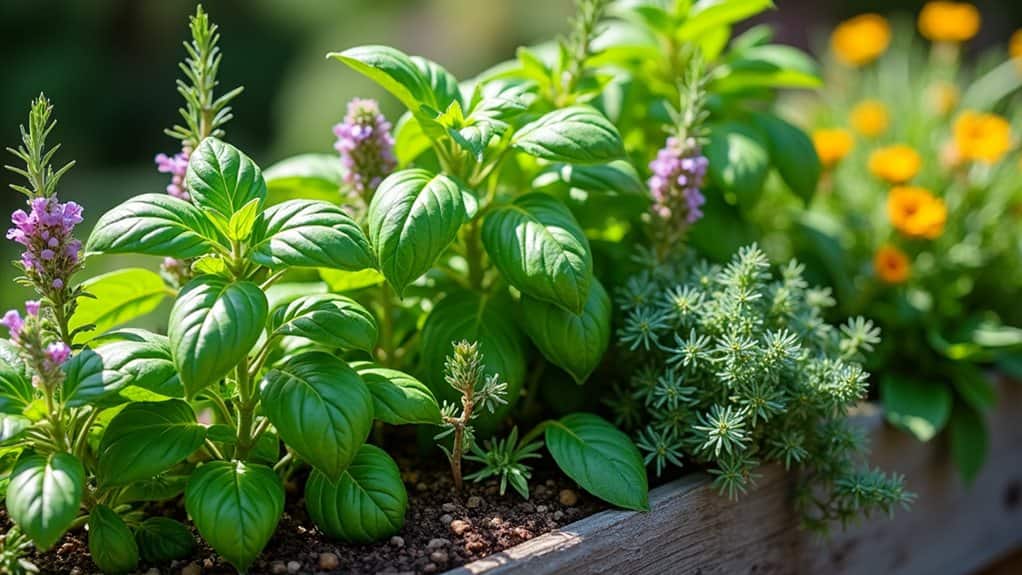
Let's talk about some of the most popular culinary herbs you can grow in your garden, shall we?
You've got your annuals like basil and cilantro, which are perfect for those summer salads and salsas. Basil is rich in antioxidants and can also add a fresh flavor to your dishes.
Then there are the perennials like rosemary and thyme that keep coming back for more year after year.
Popular Culinary Herbs
Throughout history, culinary herbs have played an essential role in enhancing flavors and elevating dishes. Imagine yourself whipping up a pasta with fresh Basil, or seasoning a roast with fragrant Rosemary. Don't forget about spicy Oregano and zesty Thyme! Each herb brings its own magic to your meals, making your kitchen feel like a gourmet restaurant. Culinary herbs are not only about flavor; they also offer numerous health benefits, enhancing your culinary experience while promoting well-being. Immerse yourself, and let your taste buds travel!
Annual vs. Perennial Herbs
When choosing herbs for your garden, you'll often find yourself deciding between annual and perennial varieties.
Annuals, like basil and cilantro, complete their life cycle in a single season and need replanting each year. Many herbs are classified as perennials, such as thyme and mint, stick around longer, popping back up each spring.
It's like having a garden buddy that doesn't ditch you after one summer!
Flavor Profiles and Uses
Herbs bring a diverse range of flavors and aromas to your cooking, enhancing dishes in unexpected ways.
Imagine sweet basil dancing with tomatoes in Italian cuisine or zesty cilantro brightening up your guacamole. Herbs contain a high concentration of volatile aromatic compounds, which contribute to their distinct flavors. Dill adds a fresh twist to seafood, while the hearty rosemary warms up any dish.
Tips for Successful Growth
A thriving herb garden starts with careful planning and attention to detail. Make sure to plant your herbs near the kitchen door for easy snipping, and give them plenty of sunlight. Keeping your soil well-draining and rich is crucial, as herbs thrive in healthy, loose soil, and water based on each herb's needs. Don't forget to prune regularly—your herbs will love you for it, and you'll grow a lush garden!
And Finally
So, there you have it! Growing your own culinary herb garden is not just fun, but it's like having a little flavor factory right outside your kitchen! Imagine grabbing fresh basil for your pasta or snipping some cilantro for tacos—yum, right? Just remember to give your plants some love, water, and a little sunshine, and you'll be on your way to becoming a herb wizard in no time. Now, go dig in and get those herbs growing! 🌱

